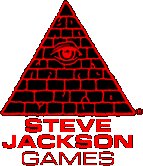


















|
You can find an index of all the GURPS bibliographies we have online here. If you spot any broken links or other problems with this page, please report them to webmaster@sjgames.com. Bibliography for GURPS Psi-TechPopular media offer many sources of inspiration for psi-tech. BooksBradley, Marion Zimmer. The Bloody Sun (Ace, 1964) and sequels. The "Darkover" series covers the science of "matrix mechanics": low-tech psychotronic generators and symbiotic crystals. Brin, David. Startide Rising (Bantam, 1983). Ultra-tech psionic devices and weapons are a minor but interesting element of the "Uplift" series. Hansen, Karl. War Games (Berkley, 1983) and Dream Games (Ace, 1985). Feature psychotronic technology coupled with genetically engineered and surgically enhanced telepaths. May, Julian. The Many-Colored Land (Collins, 1985) and Intervention (Collins, 1987). Include psychotronic amplifiers, screens, and other psi-tech. Ostrander, Sheila and Schroeder, Lynn. Psychic Discoveries (Marlowe, 1997). Nonfiction focusing on Soviet-era research; popularized the concept of psychotronics. Smith, E.E. "Doc." Triplanetary (Fantasy Press, 1948) and sequels. The "Lensman" series features symbiotic crystals ("the Lens") and artificial psi shields. Zahn, Timothy. Distant Friends and Others (Baen, 1992). The three stories that make up this sequence explore the consequences of a null-field generator for telepaths suffering from uncontrollable psi static. Zelazny, Roger. Lord of Light (Doubleday, 1967). Psi-tech and uploading allow an elite to gain powers imitating the aspects of the Hindu gods. ComicsUncanny X-Men and related series (Marvel, 1963-present). Professor X's Cerebro is a classic psi-amplifier. Psychotronic technology is constantly invented – and forgotten – over the course of this series and its many spinoff comics, games, cartoons, and movies. Manga and AnimeA Certain Magical Index and A Certain Scientific Railgun (Kamachi Kazuma, 2004-present). Series of novels, manga, and anime set in a world where psionics and magic collide, focusing on an academy city devoted to the development of psi powers. Main characters include a boy who can negate any paranormal ability, a living magic library, and an ergokinetic schoolgirl. Several mad-science psi-tech projects are featured. Akira (Katsuhiro Otomo, 1982-1990). Manga and anime movie in which government research into bio-psi goes horribly awry. MoviesDreamscape (Joseph Ruben, 1984). Innocuous dream-tech is adapted into an assassination tool. Inception (Christopher Nolan, 2010). A corporate espionage team uses a type of dreamscaper (p. 20) to steal secrets from their targets' subconscious. Push (Paul McGuigan, 2009). A motley crew of psychics band to together to destroy a government program before it can mass-produce dangerous psi-augmenting drugs. Scanners (David Cronenberg, 1981). A morning-sickness drug is found to induce psychic powers in the unborn. TelevisionFringe (J.J. Abrams, Alex Kurtzman, and Roberto Orci, 2008-2013). This series about paranormal investigation often features psi-tech. Tomorrow People, The (Roger Price, 1973-1979 and 1992-1995, U.S. remake, 2013-2014). A group of young psis (the next step in human evolution) employ psionic computers, psi-enhancing teleport belts, and other tech. | |

|